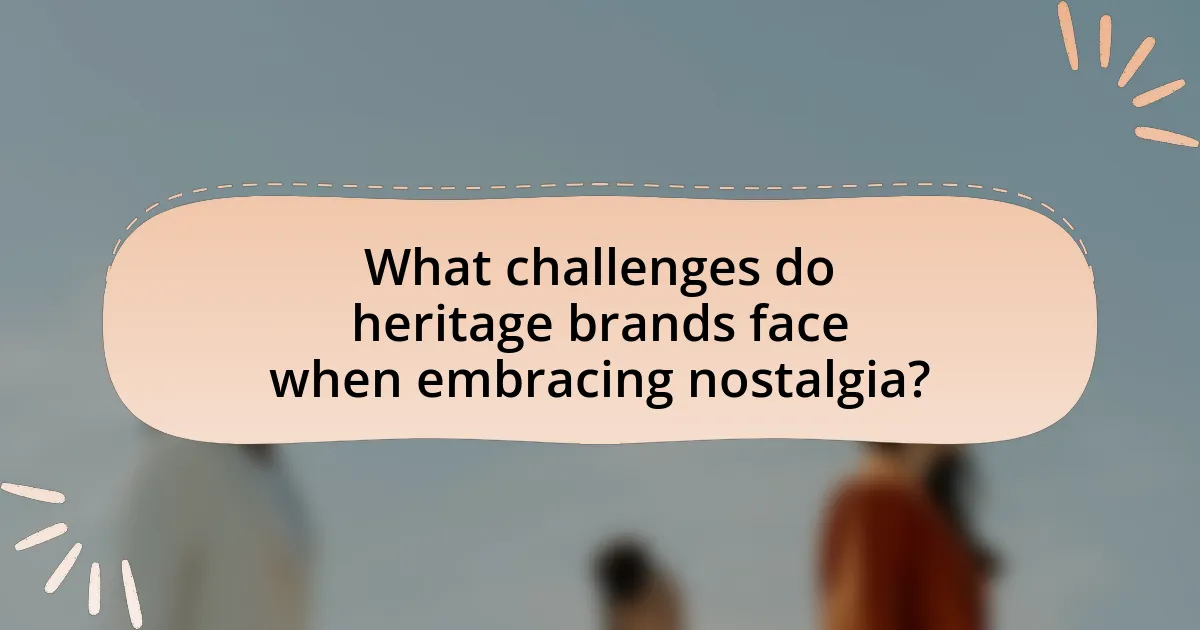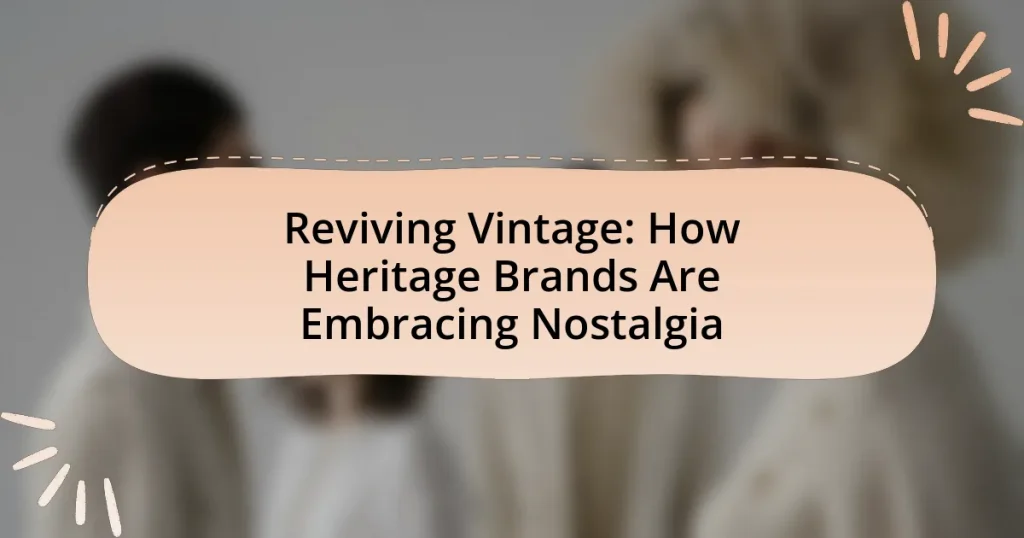The article “Reviving Vintage: How Heritage Brands Are Embracing Nostalgia” explores the strategy of heritage brands reintroducing classic designs and elements from their past to connect with modern consumers. It examines how nostalgia influences consumer behavior, enhances brand loyalty, and differentiates these brands in a competitive market. Key topics include the historical elements that evoke nostalgia, the challenges brands face in balancing authenticity with contemporary expectations, and effective marketing strategies for communicating nostalgic values. Additionally, the article provides insights into how brands can successfully revive vintage elements while maintaining authenticity and engaging younger audiences.

What is the concept of reviving vintage in heritage brands?
The concept of reviving vintage in heritage brands involves reintroducing classic designs, styles, and elements from a brand’s past to appeal to contemporary consumers. This strategy leverages nostalgia, tapping into emotional connections that consumers have with historical aesthetics and cultural significance. For instance, brands like Levi’s and Converse have successfully launched retro collections that reflect their original designs, thereby attracting both loyal customers and new audiences. This approach not only honors the brand’s legacy but also aligns with current trends favoring sustainability and authenticity in fashion.
How do heritage brands define nostalgia in their marketing strategies?
Heritage brands define nostalgia in their marketing strategies as a means to evoke emotional connections through historical authenticity and cultural significance. By leveraging their long-standing histories, these brands create campaigns that highlight traditional craftsmanship, iconic designs, and vintage aesthetics, which resonate with consumers’ memories and sentiments. For instance, brands like Levi’s and Coca-Cola utilize retro packaging and storytelling that hark back to earlier decades, effectively tapping into consumers’ longing for simpler times. This approach not only reinforces brand loyalty but also attracts new customers who appreciate the authenticity and heritage associated with these brands.
What historical elements do these brands draw upon to evoke nostalgia?
Heritage brands evoke nostalgia by drawing upon historical elements such as vintage design aesthetics, iconic advertising campaigns, and cultural milestones from past decades. For instance, brands often utilize retro packaging and classic logos that harken back to the mid-20th century, a time associated with simplicity and authenticity. Additionally, they reference significant cultural events, such as the rise of rock ‘n’ roll in the 1960s or the fashion trends of the 1980s, which resonate with consumers’ memories and emotions. This strategy is supported by research indicating that nostalgia can enhance brand loyalty and consumer engagement, as seen in studies published in the Journal of Consumer Research, which highlight how nostalgic marketing can positively influence purchasing behavior.
How does nostalgia influence consumer behavior towards heritage brands?
Nostalgia significantly influences consumer behavior towards heritage brands by evoking emotional connections that enhance brand loyalty and purchasing decisions. This emotional response is rooted in consumers’ fond memories associated with the brand, often leading to a preference for products that remind them of their past experiences. Research indicates that nostalgia can increase consumers’ willingness to pay a premium for heritage brands, as seen in a study published in the Journal of Consumer Research, which found that nostalgic feelings can enhance the perceived value of products linked to personal or cultural history. Consequently, heritage brands that effectively leverage nostalgia in their marketing strategies can foster deeper emotional ties with consumers, ultimately driving sales and brand advocacy.
Why is nostalgia important for heritage brands today?
Nostalgia is important for heritage brands today because it fosters emotional connections with consumers, enhancing brand loyalty and engagement. Heritage brands often leverage nostalgia to evoke memories of simpler times, which can resonate deeply with their target audience. For instance, a study by the Journal of Consumer Research found that nostalgic feelings can increase consumers’ willingness to pay for products, as they associate them with positive past experiences. This emotional resonance not only differentiates heritage brands in a competitive market but also drives sales by tapping into consumers’ desire for authenticity and familiarity.
What role does nostalgia play in brand loyalty and customer retention?
Nostalgia significantly enhances brand loyalty and customer retention by creating emotional connections between consumers and brands. This emotional bond is rooted in positive memories associated with past experiences, which can lead to repeat purchases and long-term loyalty. Research indicates that nostalgic feelings can increase consumers’ willingness to pay for products, as they often perceive them as more valuable when tied to cherished memories. For instance, a study published in the Journal of Consumer Research found that nostalgia can enhance consumers’ attachment to brands, making them more likely to choose those brands over competitors. This emotional engagement fosters a sense of belonging and identity, further solidifying customer loyalty and retention.
How do heritage brands leverage nostalgia to differentiate themselves in the market?
Heritage brands leverage nostalgia by evoking emotional connections to the past, which differentiates them in the market. These brands often utilize iconic designs, historical storytelling, and vintage marketing strategies to resonate with consumers’ memories and sentiments. For instance, brands like Coca-Cola and Levi’s frequently reference their long-standing histories and classic products, creating a sense of authenticity and trust. Research indicates that nostalgia can enhance consumer loyalty and increase willingness to pay, as demonstrated by a study published in the Journal of Consumer Research, which found that nostalgic feelings can lead to more favorable evaluations of brands. This strategic use of nostalgia not only reinforces brand identity but also attracts consumers seeking familiarity in an increasingly fast-paced market.

How are heritage brands implementing nostalgia in their products?
Heritage brands are implementing nostalgia in their products by reviving classic designs and utilizing vintage materials that resonate with consumers’ memories. For instance, brands like Levi’s and Coca-Cola have reintroduced retro styles and packaging that evoke a sense of familiarity and emotional connection. This strategy is supported by research indicating that nostalgia can enhance consumer loyalty and increase purchase intent, as seen in studies published in the Journal of Consumer Research, which highlight nostalgia’s role in driving emotional engagement with brands.
What types of products are being revived by heritage brands?
Heritage brands are reviving vintage clothing, accessories, and footwear. These products often include classic styles that reflect the brand’s historical roots, such as retro denim, iconic handbags, and signature sneakers. For instance, brands like Levi’s and Adidas have reintroduced styles from their archives, tapping into consumer nostalgia and the growing trend for sustainable fashion by promoting timeless designs that resonate with modern audiences. This revival not only honors the brand’s legacy but also meets the increasing demand for authentic and unique fashion items.
How do these products reflect the original designs or concepts?
These products reflect the original designs or concepts by incorporating key aesthetic elements, materials, and craftsmanship that defined the heritage brands. For instance, many brands utilize vintage patterns, color palettes, and silhouettes that were popular in their early collections, thereby maintaining a visual connection to their historical roots. Additionally, the use of traditional manufacturing techniques, such as hand-stitching or artisanal methods, reinforces the authenticity and quality associated with the original designs. This approach not only honors the brand’s legacy but also appeals to consumers’ growing desire for nostalgia and authenticity in their purchases.
What modern adaptations are being made to vintage products?
Modern adaptations to vintage products include the integration of contemporary materials, updated technology, and sustainable practices. For instance, brands are reimagining classic designs by using eco-friendly fabrics and production methods, which appeal to environmentally conscious consumers. Additionally, vintage electronics are being retrofitted with modern features such as Bluetooth connectivity and energy-efficient components, enhancing functionality while preserving aesthetic appeal. This trend is supported by market research indicating a growing consumer preference for nostalgic yet innovative products, reflecting a blend of heritage and modernity in consumer goods.
How do heritage brands communicate their nostalgic values to consumers?
Heritage brands communicate their nostalgic values to consumers through storytelling, visual branding, and product design that evoke memories of the past. These brands often utilize historical narratives that highlight their origins, craftsmanship, and cultural significance, creating an emotional connection with consumers. For example, brands like Levi’s and Coca-Cola leverage their long histories in marketing campaigns, showcasing vintage advertisements and classic product lines that resonate with consumers’ memories. This approach is supported by research indicating that nostalgia can enhance consumer attachment and brand loyalty, as seen in studies published in the Journal of Consumer Research, which demonstrate that nostalgic feelings can lead to increased willingness to pay for products associated with cherished memories.
What marketing channels are most effective for promoting nostalgia?
Social media platforms, particularly Facebook and Instagram, are the most effective marketing channels for promoting nostalgia. These platforms allow brands to share visually appealing content that resonates with users’ memories and emotions, leveraging nostalgia to create engagement. For instance, a study by the Journal of Consumer Research found that nostalgic content on social media can enhance brand attachment and increase consumer engagement by 20%. Additionally, email marketing campaigns that feature nostalgic themes have shown higher open and click-through rates, as consumers are drawn to familiar and comforting memories.
How do storytelling and branding play a role in this communication?
Storytelling and branding are essential in communicating the values and emotional connections of heritage brands, particularly in the context of nostalgia. Storytelling allows these brands to convey their history, traditions, and the unique narratives that resonate with consumers, fostering a sense of authenticity and trust. For instance, brands like Coca-Cola and Levi’s utilize storytelling to highlight their long-standing heritage, which enhances brand loyalty and emotional engagement. Research indicates that 55% of consumers are more likely to purchase from brands that tell compelling stories, demonstrating the effectiveness of this approach in driving consumer behavior. Thus, storytelling enriches branding by creating a deeper connection with the audience, making the communication more impactful and memorable.

What challenges do heritage brands face when embracing nostalgia?
Heritage brands face several challenges when embracing nostalgia, primarily the risk of alienating younger consumers who may not connect with past narratives. This disconnect can lead to a decline in relevance, as brands must balance honoring their history while appealing to contemporary tastes. Additionally, heritage brands often struggle with authenticity; if nostalgia is perceived as inauthentic or merely a marketing gimmick, it can damage brand credibility. For instance, a study by the Journal of Brand Management indicates that consumers value genuine storytelling, and brands that fail to deliver this may see diminished loyalty. Furthermore, the challenge of innovation arises, as heritage brands must find ways to modernize their offerings without losing the essence of what made them nostalgic in the first place.
How do heritage brands balance authenticity with modern consumer expectations?
Heritage brands balance authenticity with modern consumer expectations by integrating traditional craftsmanship with contemporary design and marketing strategies. These brands often emphasize their historical roots and storytelling to maintain authenticity while adapting to current trends, such as sustainability and digital engagement. For instance, brands like Levi’s and Burberry have successfully incorporated eco-friendly materials and digital platforms to appeal to younger consumers, demonstrating that they can honor their legacy while meeting modern demands. This approach not only preserves their heritage but also enhances their relevance in today’s market.
What risks are associated with over-commercialization of nostalgia?
Over-commercialization of nostalgia risks diluting the authenticity and emotional connection associated with nostalgic products. When brands excessively exploit nostalgia, they may create a superficial experience that fails to resonate deeply with consumers, leading to disillusionment. For instance, a study by the Journal of Consumer Research indicates that overexposure to nostalgic themes can result in consumer fatigue, diminishing the perceived value of nostalgic products. Additionally, this commercialization can alienate original fans who feel that their cherished memories are being commodified, ultimately harming brand loyalty and trust.
How can brands avoid alienating younger consumers while targeting nostalgia?
Brands can avoid alienating younger consumers while targeting nostalgia by integrating contemporary values and trends into their nostalgic messaging. This approach ensures that the brand resonates with younger audiences who prioritize authenticity, inclusivity, and sustainability. For instance, brands like Nike have successfully blended retro designs with modern technology and social causes, appealing to both older and younger demographics. Research indicates that 70% of millennials prefer brands that align with their values, demonstrating the importance of relevance in nostalgia marketing. By creating campaigns that reflect current social issues while invoking fond memories, brands can effectively engage younger consumers without losing the essence of nostalgia.
What strategies can heritage brands adopt to successfully revive vintage elements?
Heritage brands can successfully revive vintage elements by integrating authentic historical designs into modern products. This strategy involves researching and sourcing original materials and techniques used in past collections, ensuring that the revival maintains the brand’s integrity and authenticity. For instance, brands like Levi’s have successfully reintroduced vintage styles by utilizing archival designs and sustainable practices, which resonate with consumers’ growing preference for authenticity and sustainability. Additionally, leveraging storytelling through marketing campaigns that highlight the brand’s history and craftsmanship can enhance consumer connection and engagement, as seen in the marketing strategies of brands like Burberry, which often reference their rich heritage in promotional content.
How can brands effectively research and incorporate historical influences?
Brands can effectively research and incorporate historical influences by utilizing archival materials, engaging with historical experts, and analyzing consumer nostalgia trends. Archival materials, such as old advertisements, product designs, and company records, provide authentic insights into a brand’s heritage. Engaging with historians or cultural experts can offer deeper context and understanding of the historical significance behind certain styles or trends. Additionally, analyzing consumer nostalgia trends through market research can help brands identify which historical elements resonate with their target audience, ensuring that the incorporation of these influences aligns with current consumer preferences. For instance, a study by the Journal of Consumer Research highlights that nostalgia can enhance brand attachment, making it crucial for brands to strategically integrate historical elements that evoke positive memories.
What best practices should brands follow to maintain authenticity in their nostalgic offerings?
Brands should prioritize genuine storytelling and historical accuracy to maintain authenticity in their nostalgic offerings. By leveraging original narratives and aligning products with their true heritage, brands can create a deeper emotional connection with consumers. For instance, brands like Coca-Cola have successfully utilized their historical advertising campaigns to evoke nostalgia while remaining true to their brand identity. Additionally, engaging with long-time customers and incorporating their feedback can enhance authenticity, as seen with brands like Levi’s, which often consults its loyal customer base when reviving classic styles. This approach not only preserves the brand’s legacy but also fosters trust and loyalty among consumers.
What are some practical tips for consumers interested in vintage heritage brands?
Consumers interested in vintage heritage brands should prioritize researching the brand’s history and authenticity. Understanding the brand’s origins, craftsmanship, and cultural significance enhances the purchasing experience and ensures the item is genuine. Additionally, consumers should inspect items for quality and condition, as vintage pieces often show signs of wear that can affect value. Engaging with reputable vintage shops or online platforms that specialize in heritage brands can provide access to verified products. Lastly, joining communities or forums dedicated to vintage fashion can offer insights and recommendations, fostering a deeper appreciation for the heritage behind the brands.




